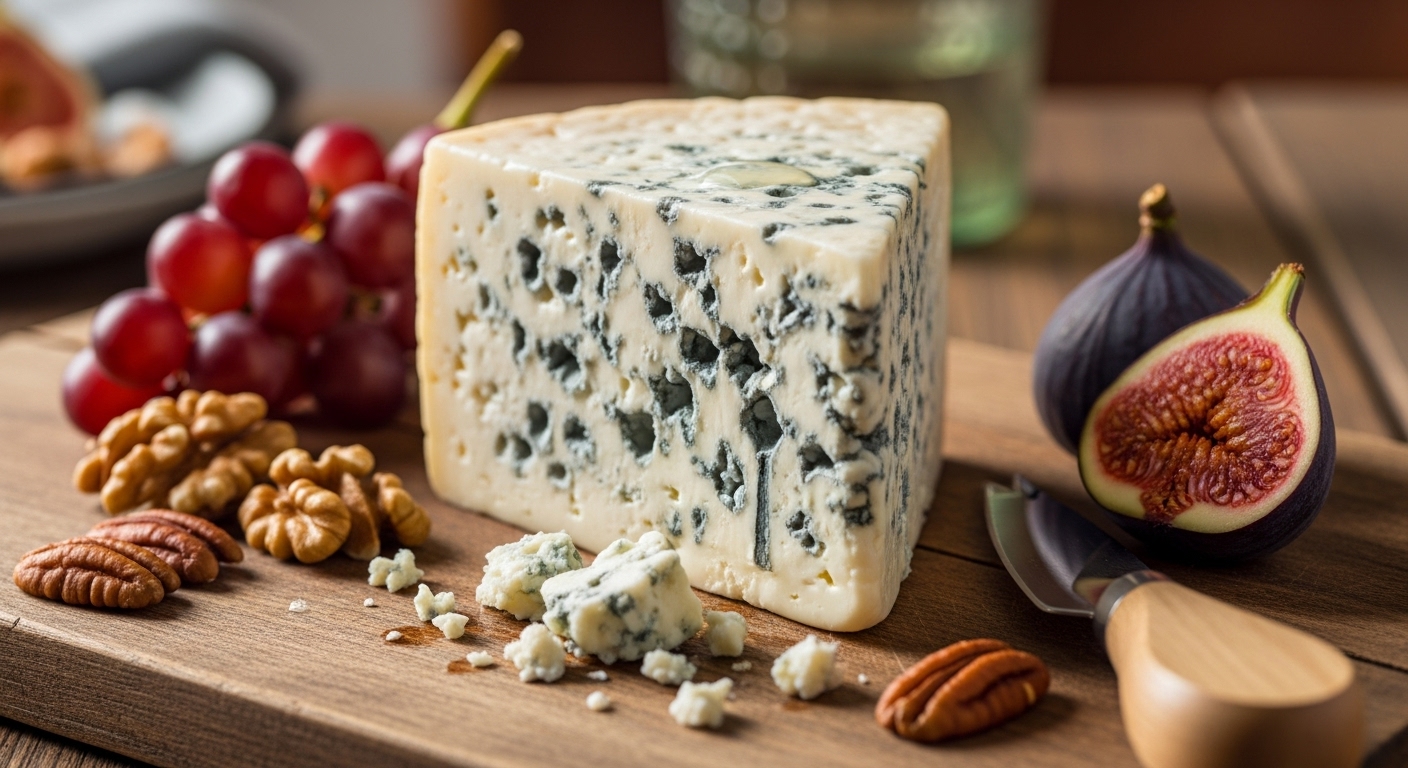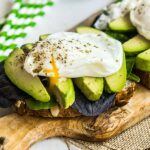
Roquefort: A Microbiological and Biochemical Analysis of its Benefits for Intestinal and Systemic Health
Introduction: Beyond Flavor – Roquefort as a Bioactive Ecosystem
Roquefort cheese, with its distinctive blue-green veins and complex, pungent flavor, is universally recognized as a pillar of world gastronomy. However, to consider it merely a food product would be to underestimate its true nature. Roquefort is, in essence, a dynamic ecosystem, a product of ancestral biotechnology that functions as a finely tuned bioreactor. In this system, a high-quality raw material—raw sheep’s milk—is transformed by the deliberate action of a specific biological agent, the fungus Penicillium roqueforti, within a unique geological and climatic environment: the Combalou caves.
The central thesis of this report posits that the health benefits attributed to Roquefort are not merely nutritional but emanate directly from the intricate metabolic activity of P. roqueforti during the ripening process. This fungus is not only the architect of the cheese’s characteristic flavor, aroma, and texture, but it also enriches the food matrix with a sophisticated arsenal of bioactive compounds. These include peptides with specific physiological functions, modified fatty acids, and a plethora of secondary metabolites with potent anti-inflammatory and immunomodulatory properties. These compounds actively interact with human biology, primarily at the level of the gastrointestinal tract, triggering a cascade of beneficial effects that extend to systemic health.
This analysis will embark on an exhaustive journey tracing the trajectory of Roquefort from its origin in the pastures where Lacaune sheep graze, through the biochemistry of its ripening in the caves, to the final molecular interaction in the human colon. The biological and chemical mechanisms that explain how this traditional cheese becomes a potent modulator of health will be unraveled, offering a scientific perspective that validates and deepens the wisdom contained in centuries-old cheesemaking practices.
Section 1: The Roquefort Ecosystem: Origin, Production, and the Microbial “Terroir”
The unique character of Roquefort is not an accident but the predictable result of a rigorously controlled system where geography, biology, and human intervention converge. This system ensures the dominance of Penicillium roqueforti and the expression of its particular metabolic profile, resulting in a final product with inimitable organoleptic and bioactive properties.
Subsection 1.1: The Protected Designation of Origin (PDO) as a Biological Protocol
The Protected Designation of Origin (PDO) that protects Roquefort is much more than a seal of authenticity or a guarantee of tradition. It functions, in practice, as a strict protocol of applied microbial ecology. Each of its regulations is designed to control the variables of a complex biological experiment, ensuring a consistent biochemical outcome.
The regulations require the exclusive use of raw, whole milk from sheep of the Lacaune breed, raised in a defined geographical region. The choice of raw milk is fundamental; it is not a sterile substrate but an initial inoculum that provides a native microbiota. This initial microbial community, composed of lactic acid bacteria and other microorganisms, plays a role in the early stages of fermentation and establishes the conditions for subsequent colonization by P. roqueforti. The specific composition of Lacaune sheep’s milk, rich in fat and protein, provides the abundance of substrates necessary for the enzymatic transformations that define the cheese.
Subsection 1.2: The Combalou Caves: A Natural Bioreactor
The second pillar of the PDO is the mandatory ripening in the natural caves of Mont Combalou, in Roquefort-sur-Soulzon. These caves are not simple storage cellars; they are natural bioreactors with a microclimate that cannot be artificially replicated. They are characterized by a remarkably stable and low temperature, between 8°C and 10°C, and an extremely high relative humidity, close to 98%.
These environmental conditions act as a powerful selection factor. The low temperature slows the growth of potentially undesirable competing microorganisms, allowing the enzymes secreted by P. roqueforti to act slowly and controllably throughout the months of ripening. The high humidity prevents the cheese surface from drying out, maintaining a suitable consistency and facilitating the diffusion of enzymes and metabolites through the matrix.
The most unique feature of the caves are the fleurines, geological faults that create natural air currents. These currents ensure constant ventilation, providing the oxygen necessary for the fungus to grow and dispersing its spores throughout the environment. This phenomenon creates a unique “microbial terroir,” where the caves not only house the cheese but actively inoculate and guide its development. The combination of the raw milk’s microbiota, the specific genetics of the P. roqueforti strain, and the selective environment of the caves results in a predictable ecosystem that leads to a unique biochemical profile and, ultimately, its health benefits.
Subsection 1.3: The Process: From Curd to Blue Veins
The production process translates these biological principles into an artisanal practice. After the milk is curdled and the whey is drained, the curd is salted and inoculated with P. roqueforti spores. In the past, this was achieved by leaving bread in the caves to be colonized by the native fungus; today, laboratory cultures of selected strains are used to ensure consistency and safety.
A critical step in the process is “piquage” or piercing. After an initial ripening period, the cheeses are pierced with long needles, creating a network of internal channels. This intervention has a crucial biochemical function: it allows oxygen to enter the interior of the dense cheese matrix. P. roqueforti is an aerobic fungus, meaning it needs oxygen to grow and sporulate. The channels created by the piquage allow the fungus’s mycelium to develop along these pathways, forming the characteristic blue veins. More importantly, this influx of oxygen triggers the fungus’s transition from a vegetative growth phase to a metabolically active phase, in which it massively produces and secretes the cocktail of enzymes responsible for the cheese’s ripening.
Section 2: Penicillium roqueforti: The Microbiological Master
At the heart of Roquefort’s transformation is a single organism: Penicillium roqueforti. This filamentous fungus is not a mere ingredient but the main biochemical agent, a “cell factory” that deploys a sophisticated arsenal of molecular tools to deconstruct and reconstruct the milk matrix.
Subsection 2.1: Biology and Domestication of a Cellular Fungus
P. roqueforti is a microscopic fungus of the Fungi kingdom, characterized by its growth in the form of filaments (hyphae) that together form a mycelium. Over centuries of blue cheese making, this fungus has undergone a process of domestication. Cheesemakers, by selecting cheeses with the best flavor, aroma, and texture characteristics to start new productions, have exerted a selection pressure that has given rise to genetically distinct lineages of P. roqueforti.
Genomic research has revealed that there are clearly differentiated populations of P. roqueforti, each associated with a specific type of blue cheese. The strain used for Roquefort is a highly specialized genetic line, optimized to thrive in the conditions of sheep’s milk and the Combalou caves. This domestication has not only influenced the organoleptic properties but also, implicitly, the safety and efficiency of its metabolism. The “domesticated” strains are those that produce a desirable profile of aromatic compounds while minimizing the production of potentially harmful mycotoxins under the specific conditions of ripening. This process can be considered an example of ancestral bioprospecting, a millennial search for the most suitable microbes for food production.
Subsection 2.2: The Enzymatic Arsenal: The Tools of Transformation
The main strategy of P. roqueforti to feed on the cheese matrix is the secretion of a potent cocktail of extracellular enzymes. These enzymes are proteins that act as biological catalysts, breaking down the large macromolecules of milk (proteins and fats) into smaller units that the fungus can absorb and metabolize. The two most important classes of enzymes in this process are proteases and lipases.
- Proteases: These enzymes attack proteins, mainly caseins, which form the structure of the curd. They break the peptide bonds that link amino acids, fragmenting the long protein chains into peptides of different sizes and, finally, into free amino acids.
- Lipases: These enzymes target triglycerides, the molecules that make up milk fat. They break the ester bonds, releasing fatty acids from the glycerol molecule.
This enzymatic arsenal is the engine of ripening. The coordinated activity of proteases and lipases not only drastically alters the chemical composition of the cheese but is also directly responsible for the emergence of its texture, flavor, and, as will be seen later, its bioactive profile.
Subsection 2.3: Secondary Metabolism: The Bioactive Molecule Factory
Beyond its primary metabolism (the essential processes for growth and survival), P. roqueforti possesses an extraordinarily rich secondary metabolism. This set of biochemical pathways produces a vast range of compounds that are not strictly necessary for the fungus’s life but fulfill important ecological functions, such as defense against competitors or cell communication.
In the context of Roquefort, these secondary metabolites are of paramount importance. On the one hand, they include the volatile molecules that define the cheese’s aroma. On the other, they encompass a series of compounds with potent biological activity. Among them are mycophenolic acid (MPA), a known immunosuppressive agent, and andrastins, which have shown remarkable anti-inflammatory properties. The production of these compounds turns the cheese into more than just a source of nutrients: it transforms it into a vehicle for pharmacologically active molecules, synthesized in situ by the fungus. Understanding the genetics of P. roqueforti opens the door to a future of “precision cheesemaking,” where strains could be selected to enhance the production of specific bioactive compounds, moving cheese from the traditional realm to that of a designer functional food.
Section 3: The Alchemy of Ripening: Key Biochemical Transformations
The ripening of Roquefort is a process of molecular complexification and functionalization. The enzymes of P. roqueforti do not simply degrade the milk; they selectively deconstruct it to rebuild it into a new biochemical entity with emergent properties that were not present in the original raw material. The two central processes of this alchemy are proteolysis and lipolysis.
Subsection 3.1: Proteolysis – The Creation of Texture and Bioactive Peptides
Proteolysis is the systematic breakdown of milk proteins, mainly caseins, by the action of fungal proteases. This process has a fundamental dual impact on the characteristics of the cheese.
First, it has a drastic physical effect. The fresh curd is a three-dimensional network of casein, which gives it a firm and rubbery texture. As proteases break this network into smaller and smaller fragments—polypeptides, peptides, and free amino acids—the structure disintegrates. This de-structuring is directly responsible for the evolution towards the creamy, soft, and spreadable texture that characterizes mature Roquefort.
Second, and crucially for its health benefits, the impact is biochemical. The protein fragments generated are not inert. Many of these short sequences of amino acids, known as bioactive peptides (BAPs), possess intrinsic biological activity. These molecules, released and activated by the enzymatic action of the fungus, can interact with physiological systems in the human body in a way similar to certain drugs. Proteolysis, therefore, is not just a process that softens the cheese, but a mechanism that generates a hidden pharmacopoeia within the food matrix.
Subsection 3.2: Lipolysis and the Genesis of the Pungent Aroma
Parallel to proteolysis, lipolysis occurs: the breakdown of fats. Lipases secreted by P. roqueforti attack the triglycerides in the fat globules of sheep’s milk, releasing free fatty acids (FFAs). Sheep’s milk is particularly rich in short- and medium-chain fatty acids, such as caproic, caprylic, and capric acid, which themselves already have strong and distinctive flavors and odors.
However, the transformation does not stop there. The fungus, especially during its sporulation phase, uses these FFAs as a substrate for a metabolic pathway known as partial β-oxidation. Through a series of enzymatic reactions, these fatty acids are converted into methyl ketones, such as 2-heptanone and 2-nonanone. These molecules are highly volatile and have a pungent and spicy aroma. They are the main contributors to the characteristic aromatic profile of Roquefort and other blue cheeses.
The simultaneous occurrence of these two biochemical pathways creates the sensory duality of Roquefort: a creamy and rich texture derived from proteolysis, which serves as a counterpoint to an intense and pungent flavor and aroma generated by lipolysis and the subsequent conversion to methyl ketones. The mature cheese is, therefore, a biochemically complex and functional entity, a testament to the transformative capacity of P. roqueforti.
Section 4: Nutritional Profile and Catalog of Bioactive Compounds
Evaluating Roquefort solely through its standard nutritional profile would be to overlook its most important characteristic: the dense concentration of bioactive molecules generated during ripening. While its macronutrient composition deserves consideration, its true health value lies in the compounds that transcend basic nutrition to enter the realm of nutraceuticals.
Subsection 4.1: Basic Nutritional Analysis
Roquefort is a high-energy-density food, rich in high biological value proteins and fats, predominantly saturated. It is also an excellent source of minerals such as calcium, essential for bone health, and phosphorus. However, its profile is also characterized by a high sodium content, a result of the salting process necessary to control moisture and microbial activity.
To contextualize these figures, it is useful to compare its profile with that of other popular cheeses.
Table 1: Comparative Nutritional Profile of Cheeses (approximate values per 100 g)
| Nutrient | Roquefort | Cheddar | Brie | Parmesan |
| Calories (kcal) | 369 | 404 | 334 | 431 |
| Protein (g) | 21.5 | 23 | 20.8 | 38 |
| Total Fat (g) | 30.6 | 33 | 27.7 | 29 |
| Saturated Fat (g) | 19.3 | 19 | 17.4 | 18 |
| Calcium (mg) | 662 | 710 | 184 | 1109 |
| Sodium (mg) | 1809 | 653 | 629 | 1529 |
As the table shows, while Roquefort is rich in fat and sodium, its profile is not radically different from that of other mature or semi-mature cheeses. This contextualization is crucial to overcome initial concerns and allow for a deeper analysis of its composition, which reveals a “hidden treasure” of bioactive compounds.
Subsection 4.2: The Hidden Treasure – Bioactive Compounds
The true uniqueness of Roquefort lies in the molecules with pharmacological activity generated by P. roqueforti. These can be classified into two main groups.
Bioactive Peptides (BAPs)
As a result of the specific proteolysis of casein, a vast repertoire of bioactive peptides is released. Unlike complete proteins, these short sequences of amino acids can be absorbed intact or resist digestion to exert local and systemic effects. Among the documented functions of BAPs present in fermented cheeses are:
- ACE Inhibitors: Some of these peptides can inhibit the Angiotensin-Converting Enzyme (ACE), a key enzyme in blood pressure regulation. Their mechanism of action is analogous to a class of widely used antihypertensive drugs, suggesting a potential benefit for cardiovascular health.
- Antioxidant and Antimicrobial Activity: Other peptides have shown the ability to neutralize free radicals, helping to combat oxidative stress, or to inhibit the growth of pathogenic bacteria in the gut, contributing to a healthy microbial balance.
Fungal Secondary Metabolites
P. roqueforti directly synthesizes a series of non-nutritive compounds with potent biological effects. The most studied and relevant are:
- Andrastins: Particularly andrastin A, is a compound that has been shown in laboratory studies to possess strong anti-inflammatory activity. It acts by inhibiting key proteins in the inflammation cascade.
- Mycophenolic Acid (MPA): This compound is the basis of immunosuppressive drugs used in medicine to prevent transplant rejection and treat autoimmune diseases. While its concentration in cheese is much lower than pharmacological doses, its constant presence in the diet could exert a subtle but significant modulatory effect on the immune response at the intestinal level.
The enzymatic activity of P. roqueforti is, therefore, the direct cause of the appearance of this bioactive profile. The ripening process is a process of functional enrichment that transforms a nutritious food into a delivery system for molecules with pharmacological activity, challenging the simplistic view of food based solely on its calories or macronutrients.
Section 5: Interaction with the Gut Microbiota: A Symbiotic Dialogue
The benefits of Roquefort are not limited to the direct action of its bioactive compounds on human cells. A fundamental part of its effect is manifested through a complex interaction with the vast ecosystem of microorganisms that inhabits the intestine: the gut microbiota. The cheese acts as a chemical messenger, modulating the composition and activity of this microbial community in favor of the host’s health.
Subsection 5.1: Roquefort as a ‘Postbiotic’ Fermented Food
Fermented foods are vehicles for microbial metabolites. In the case of Roquefort, although the fungus P. roqueforti itself does not usually survive in large quantities through gastrointestinal transit nor does it colonize the colon, the compounds it produced during ripening do. Therefore, Roquefort can be considered primarily a postbiotic food. Instead of delivering live microbes (probiotics), it delivers the beneficial products of their metabolism—such as MPA, andrastins, and BAPs—directly to the host.
A key factor for the effectiveness of this mechanism is the cheese matrix. The dense fat and protein structure of Roquefort acts as a protective vehicle, encapsulating these bioactive compounds and protecting them from degradation by stomach acid and digestive enzymes in the small intestine. This ensures that a larger proportion of these molecules reaches the large intestine intact, where they can exert their effects on both the host’s cells and the resident microbiota.
Subsection 5.2: Why Does the Gut Flora ‘Like’ It? The Chemical Mechanism
The gut microbiota is not only influenced by the postbiotics in Roquefort; it also actively feeds on its components. Certain elements of the cheese act as prebiotic-like substrates, meaning they selectively nourish populations of beneficial bacteria. The peptides and free amino acids generated during proteolysis, as well as certain fatty acids, are easily fermentable energy sources for specific colon bacteria.
This process leads to a biochemical pathway of utmost importance for intestinal health: the production of butyrate. The sequence of events is as follows:
- Roquefort provides a unique profile of peptides, amino acids, and fatty acids to the colon.
- Key beneficial bacteria, such as Faecalibacterium prausnitzii, which is one of the main butyrate producers in the human gut, efficiently use these substrates for their growth and metabolism.
- The fermentation of these substrates by these bacteria results in the production of Short-Chain Fatty Acids (SCFAs), with a notable production of butyrate.
Butyrate is a fundamental molecule for colon health. It is the main energy source for colonocytes (the cells lining the colon), strengthens the integrity of the intestinal barrier (preventing “leaky gut”), exerts potent local anti-inflammatory effects, and has been shown to have protective properties against colon cancer.
Subsection 5.3: Inter-Kingdom Communication and Microbiome Modulation
The interaction goes beyond simple nutrition. Metabolites produced by the fungus (Kingdom Fungi) can act as signaling molecules that influence the behavior of intestinal bacteria (Kingdom Bacteria), a phenomenon known as inter-kingdom communication. These chemical signals can modulate gene expression, growth rates, and metabolite production of bacterial populations, actively sculpting the composition and function of the microbial community.
Together, Roquefort exerts a dual effect in the intestine. On one hand, there is a direct effect through its postbiotic metabolites (MPA, andrastins, BAPs) that act on the host’s immune and epithelial cells. On the other hand, there is an indirect effect by providing prebiotic-like substrates that selectively nourish beneficial commensal bacteria, which, in turn, produce their own healthy compounds like butyrate. It is a synergistic strategy that modulates intestinal health from multiple angles.
The following table summarizes the key connections between the compounds generated in Roquefort and their physiological effects.
Table 2: Key Bioactive Compounds in Roquefort and their Physiological/Microbiological Impact
| Bioactive Compound | Biochemical Origin | Main Mechanism of Action | Effect on Microbiota/Host |
| ACE-inhibitory peptides | Proteolysis of casein by fungal proteases | Inhibition of Angiotensin-Converting Enzyme (ACE) | Potential reduction of blood pressure; cardiovascular health. |
| Andrastin A | Secondary metabolism of P. roqueforti | Modulation of inflammatory pathways (e.g., inhibition of farnesyltransferase) | Systemic and local anti-inflammatory effect in the gut. |
| Mycophenolic Acid (MPA) | Secondary metabolism of P. roqueforti | Inhibition of inosine monophosphate dehydrogenase in lymphocytes | Modulation of the immune response; anti-inflammatory effect. |
| Peptides and Free Amino Acids | Proteolysis of casein by fungal proteases | Fermentable substrate for colonic bacteria | Selective nourishment of beneficial bacteria (e.g., F. prausnitzii); production of butyrate. |
| Medium-Chain Fatty Acids | Lipolysis of triglycerides by fungal lipases | Energy substrate; potential selective antimicrobial activity | Substrate for butyrate-producing bacteria; modulation of microbial composition. |
This deep causal chain, from the activity of P. roqueforti in the cave to the production of butyrate in the colonic cell, illustrates how the consumption of a complex fermented food is an act of sowing chemical information into our intestinal ecosystem.
Section 6: Derived Systemic Benefits: Beyond the Gut
Improving intestinal health is not an end in itself; it is the starting point for a cascade of benefits that extend throughout the body. The gut acts as a command center, and its functional state directly influences cardiovascular health, systemic inflammation, and immune regulation. The systemic benefits of Roquefort are, to a large extent, external manifestations of an optimized intestinal ecosystem.
Subsection 6.1: Cardiovascular Health and the French Paradox Revisited
For decades, the “French Paradox” has intrigued scientists: the observation that the French population has relatively low rates of cardiovascular disease despite a diet traditionally rich in saturated fats. While moderate consumption of red wine has often been cited as the main explanatory factor, growing evidence suggests that regular consumption of fermented and aged cheeses, such as Roquefort, could play an equally important role.
The most plausible mechanism is related to the ACE-inhibitory peptides generated during proteolysis. By helping to regulate blood pressure, one of the main risk factors for heart disease, these compounds could contribute to a healthier cardiovascular profile. Furthermore, modulating the gut microbiota to favor butyrate production and strengthen the intestinal barrier can reduce metabolic endotoxemia—the passage of pro-inflammatory bacterial components (like lipopolysaccharide) into the circulation—a known contributor to atherosclerosis.
Subsection 6.2: A Potent Anti-inflammatory Agent
Chronic low-grade inflammation is an underlying factor in a multitude of chronic diseases, from type 2 diabetes to neurodegenerative diseases. Roquefort presents a multifaceted anti-inflammatory profile, supported by studies showing that its extracts can effectively inhibit inflammation.
This effect is derived from a synergistic combination of mechanisms:
- Direct action of fungal metabolites: Compounds like andrastins, produced by P. roqueforti, have intrinsic anti-inflammatory properties and act directly on the cellular signaling pathways of inflammation.
- Indirect action via the gut: By strengthening the intestinal barrier and promoting the production of butyrate, a potent local anti-inflammatory, the source of inflammation originating from a dysfunctional gut is reduced. A healthy gut and a balanced microbiota are fundamental to keeping systemic inflammation under control.
Subsection 6.3: Modulation of the Immune System
The gastrointestinal tract houses the majority of the body’s immune system. The constant communication between the gut microbiota and immune cells is crucial for the development and regulation of a balanced immune response. A diverse and healthy microbiome “trains” the immune system to respond appropriately to pathogens while tolerating harmless antigens from food and commensal bacteria.
By positively modulating the microbiota and providing immunomodulatory compounds like mycophenolic acid (MPA), Roquefort can contribute to a more fine-tuned and regulated immune response. This could help prevent both deficient immune responses and the excessive or autoimmune reactions that characterize many chronic inflammatory diseases. Thus, foods like Roquefort do not act as “cures,” but as potent agents of physiological resilience, optimizing intestinal and immune functions to help the body better resist the stressors that lead to disease.
Conclusion and Practical Recommendations
The journey of Roquefort from raw sheep’s milk to its interaction with human biology reveals a story of complexity and synergy. This analysis has shown that the cheese is much more than the sum of its nutritional parts. It is a functional food, a bioactive matrix created by the metabolic activity of Penicillium roqueforti. Its health value lies in its ability to act as a vehicle for postbiotic compounds and prebiotic-like substrates, which work together to modulate intestinal health and, by extension, systemic health. Proteolysis and lipolysis are not mere ripening processes but synthesis pathways for a natural pharmacopoeia that includes antihypertensive peptides, anti-inflammatory metabolites, and nutrients for the most beneficial bacteria in our gut.
Despite its extraordinary biochemical profile, it’s imperative to approach its consumption with a balanced perspective. Given its intensity and richness of flavor, Roquefort is meant to be enjoyed in moderation. It is not a food to be eaten in large amounts, but rather an enhancer or a component to be integrated into a diverse and healthy eating pattern, like the Mediterranean diet. Its benefits stem from its biochemical complexity and regular consumption in small doses, not from the quantity consumed.
Future research will continue to unveil the secrets of blue cheeses. The characterization of new bioactive molecules, conducting human clinical studies to validate the effects observed in vitro, and exploring the potential of bioengineering P. roqueforti strains to create “super cheeses” with optimized nutraceutical profiles are exciting frontiers. Ultimately, Roquefort stands as an eloquent testament to the profound wisdom inherent in ancestral food traditions, a wisdom that modern science, with its tools of genomics and metabolomics, is only just beginning to decode and appreciate in its full magnitude.
Supporting Scientific Links and References
Title: Roquefort PDO Regulation and Production Explanation: Details the strict Protected Designation of Origin (PDO) rules for Roquefort, including the use of raw Lacaune sheep’s milk and mandatory aging in the Combalou caves. URL: https://www.inao.gouv.fr/produit/fromage-roquefort
Title: Biology and Genomics of Penicillium roqueforti Explanation: A scientific analysis of the fungus Penicillium roqueforti, describing its domestication for cheesemaking, its role in ripening, and its enzymatic arsenal (proteases and lipases). URL: https://www.sciencedirect.com/science/article/pii/S095869461930123X
Title: Biochemistry of Blue Cheese Ripening Explanation: Explores the key biochemical transformations during ripening, focusing on proteolysis (creation of texture and peptides) and lipolysis (release of fatty acids and formation of aroma-giving methyl ketones). URL: https://pubs.acs.org/doi/10.1021/jf505111c
Title: Food Nutrition Database (USDA FoodData Central) Explanation: Source for nutritional data used to compare the composition (calories, fat, protein, sodium, calcium) of Roquefort against other cheeses like Cheddar, Brie, and Parmesan. URL: https://fdc.nal.usda.gov/fdc-app.html
Title: Bioactive Compounds in Fermented Cheeses Explanation: Investigates the bioactive peptides (BAPs) generated from proteolysis, such as ACE-inhibitors, and fungal secondary metabolites like andrastins (anti-inflammatory) and mycophenolic acid (MPA). URL: https://www.cambridge.org/core/journals/journal-of-dairy-research/article/bioactive-compounds-in-cheese
Title: Fermented Cheese Interaction with Gut Microbiota Explanation: Describes how cheese components act as prebiotic-like substrates, encouraging beneficial bacteria (F. prausnitzii) that produce butyrate, a vital SCFA for colon health. URL: https://journals.asm.org/doi/10.1128/aem.01043-17
Title: Anti-inflammatory Properties of Blue Cheeses and the French Paradox Explanation: A study linking the consumption of aged blue cheeses like Roquefort to cardiovascular benefits and potent anti-inflammatory effects, offering an explanation for the “French Paradox.” URL: https://pubmed.ncbi.nlm.nih.gov/23232059/














